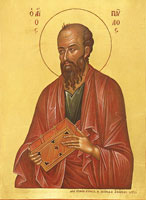Student Zone
Religious texts » New Testament » The writings of Paul
 Paul's 13-14 letters make up the bulk of the rest of the New Testament. The story of Paul's conversion on the road to Damascus is recounted in the book of Acts, and would have taken place between 31 and 36AD. He then began to preach, travelling all over the Roman Empire, founding churches and encountering hostility from local people, the authorities and even other Christians.
Paul's 13-14 letters make up the bulk of the rest of the New Testament. The story of Paul's conversion on the road to Damascus is recounted in the book of Acts, and would have taken place between 31 and 36AD. He then began to preach, travelling all over the Roman Empire, founding churches and encountering hostility from local people, the authorities and even other Christians.
Paul eventually began to write (or more probably to dictate) letters, known as epistles, to the churches he had founded, often in response to particular issues they faced or questions they had asked in letters to him. The letters that survive, as well as other letters which were probably written by other people, are included in the New Testament. Some of the "disputed" letters either claimed to be from Paul and others were attributed to him in the early centuries of the Church by mistake.
Seven letters are generally classified as "undisputed"; most scholars accept that they are the work of Paul and were probably written in this sequence and at these dates.
• 1 Thessalonians (c51AD)
• Philippians (c52-54AD)
• Philemon (c52-54AD)
• 1 Corinthians (c53-54AD)
• Galatians (c55AD)
• 2 Corinthians (c55-56AD)
• Romans (c55-58AD)
Six additional letters bearing Paul's name do not currently enjoy the same consensus: Ephesians, Colossians, 2 Thessalonians, 1 and 2 Timothy, and Titus. There is no consensus on whether the first three, called the "Deutero-Pauline Epistles" are authentic letters of Paul. The latter three, the "Pastoral Epistles", are widely regarded to be pseudepigraphical works, though certain scholars do consider Paul to be the author. Since the early centuries of the Church, there has been debate concerning the authorship of the anonymous Epistle to the Hebrews, and modern scholars reject Pauline authorship.
In trying to establish the authorship of the epistles scholars refer to internal evidence (comments within the letters about the author), external evidence (references to or from the text in other works) and comments which seem to reflect a particular historical context, a particular stage of theological development or the linguistic/literary origin of the text.
Implications of doubts over authorship of texts ascribed to Paul
Of course, the suggestion that some of the Pauline epistles were not written by Paul casts doubt on the doctrine that depends on textual references from disputed epistles.
For example, misogyny in the Church (to the extent of denying women any formal education or access to work) has been supported with references from 1 and 2 Timothy. 1 Timothy 2:11-15 reads: "A woman should learn in quietness and full submission. I do not permit a woman to teach or to assume authority over a man; she must be quiet. For Adam was formed first, then Eve. And Adam was not the one deceived; it was the woman who was deceived and became a sinner. But women will be saved through childbearing". And in 2 Timothy 3:6-7 the writer warns against men who deceive "gullible women", who he says "are loaded down with sins and are swayed by all kinds of evil desires, always learning but never able to come to a knowledge of the truth".
Now that the authorship of the letters of Timothy has been disputed, many Protestants feel able to move away from its teaching, allowing women to study, teach and even preach. Nevertheless, there are many other potentially misogynistic references in the epistles, in 1 Corinthians 7:27, 11:3, 11:5-6; 14:34-35 (which are generally considered authentically Pauline) as well as in Ephesians 5:22-24, Colossians 3:18 and Titus 2:4-5. Removing theologically embarrassing and pseudepigraphical texts from the New Testament canon has not been seriously considered by the Churches, despite the scholarly consensus. SE Porter has argued that "if the Church and its scholars are no longer willing to accept the Pastoral Epistles as written by Paul, perhaps it should eliminate them as forgeries that once deceived but will no longer" (The Canon Debate, ed McDonald and Sanders, 2002, Hendrickson Publishers Inc).
Of course it is more difficult for the Roman Catholic Church to make significant changes in direction, because of the Church's reliance on the popes and Magesteria as witness to the Holy Spirit. A teaching, once made, is difficult to contradict, though it may be qualified and interpreted. However the Roman Catholic Church has never relied on textual references to the same extent as Protestant Churches. The Catholic Church has always seen them as sources which need to be interpreted and read "through the lens of doctrine" by those who are guided by a Catholic conscience and the Holy Spirit. More extreme practices, which have been indicated by close adherence to a literal reading of texts, tend not to have been part of Catholic teaching.


